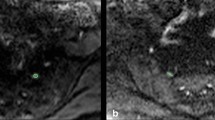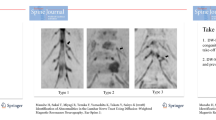Abstract
Purpose
Magnetic resonance (MR) neurography has been used to evaluate entire nerves and nerve bundles by providing better contrast between the nerves and the surrounding tissues. The purpose of the study was to validate diffusion-weighted MR (DW-MR) neurography in visualizing the lumbar plexus during preoperative planning of lateral transpsoas surgery.
Methods
Ninety-four (188 lumbar plexuses) spine patients underwent a DW-MR examination of the lumbar plexus in relation to the L3–4 and L4–5 disc spaces and superior third of the L5 vertebral body. Images were reconstructed in the axial plane using high-resolution Maximum Intensity projection (MIP) overlay templates at the disc space and L3–4 and L4–5 interspaces. 10 and 22 mm MIP templates were chosen to mimic the working zone of standard lateral access retractors. The positions of the L4 nerve root and femoral nerve were analyzed relative to the L4–5 disc in axial and sagittal planes. Third-party radiologists and a senior spine surgeon performed the evaluations, with inter- and intraobserver testing performed.
Results
In all subjects, the plexus was successfully mapped. At L3–4, in all but one case, the components of the plexus (except the genitofemoral nerve) were located in the most posterior quadrant (zone IV). The L3 and L4 roots coalesced into the femoral nerve below the L4–5 disc space in all subjects. Side-to-side variation was noted, with the plexus occurring in zone IV in 86.2 % right and only 78.7 % of left sides. At the superior third of L5, the plexus was found in zone III in 27.7 % of right and 36.2 % of left sides; and in zone II in 4.3 % right and 2.1 % left sides. Significant inter- and intraobserver agreement was found.
Conclusions
By providing the surgeon with a preoperative roadmap of the lumbar plexus, DW-MR may improve the safety profile of lateral access procedures.





Similar content being viewed by others
References
Park DK, Lee MJ, Lin EL, Singh K, An HS, Phillips FM (2010) The relationship of intrapsoas nerves during a transpsoas approach to the lumbar spine: anatomic study. J Spinal Disord Tech 23:223–228
Pimenta L, Oliveira L, Schaffa T, Coutinho E, Marchi L (2011) Lumbar total disc replacement from an extreme lateral approach: clinical experience with a minimum of 2 years’ follow-up. J Neurosurg Spine 14:38–45
Banagan K, Gelb D, Poelstra K, Ludwig S (2011) Anatomic mapping of lumbar nerve roots during a direct lateral transpsoas approach to the spine: a cadaveric study. Spine (Phila Pa 1976) 36:E687–E691
Benglis DM, Vanni S, Levi AD (2009) An anatomical study of the lumbosacral plexus as related to the minimally invasive transpsoas approach to the lumbar spine. J Neurosurg Spine 10:139–144
Dakwar E, Vale FL, Uribe JS (2011) Trajectory of the main sensory and motor branches of the lumbar plexus outside the psoas muscle related to the lateral retroperitoneal transpsoas approach. J Neurosurg Spine 14:290–295
Davis TT, Bae HW, Mok JM, Rasouli A, Delamarter RB (2011) Lumbar plexus anatomy within the psoas muscle: implications for the transpsoas lateral approach to the L4–L5 disc. J Bone Joint Surg Am 93:1482–1487
Deukmedjian AR, Le TV, Dakwar E, Martinez CR, Uribe JS (2012) Movement of abdominal structures on magnetic resonance imaging during positioning changes related to lateral lumbar spine surgery: a morphometric study: clinical article. J Neurosurg Spine 16:615–623
Guerin P, Obeid I, Gille O et al (2011) Safe working zones using the minimally invasive lateral retroperitoneal transpsoas approach: a morphometric study. Surg Radiol Anat 33:665–671
Guerin P, Obeid I, Bourghli A et al (2012) The lumbosacral plexus: anatomic considerations for minimally invasive retroperitoneal transpsoas approach. Surg Radiol Anat 34:151–157
Hu WK, He SS, Zhang SC et al (2011) An MRI study of psoas major and abdominal large vessels with respect to the X/DLIF approach. Eur Spine J 20:557–562
Kepler CK, Bogner EA, Herzog RJ, Huang RC (2011) Anatomy of the psoas muscle and lumbar plexus with respect to the surgical approach for lateral transpsoas interbody fusion. Eur Spine J 20:550–556
Lu S, Chang S, Zhang YZ, Ding ZH, Xu XM, Xu YQ (2011) Clinical anatomy and 3D virtual reconstruction of the lumbar plexus with respect to lumbar surgery. BMC Musculoskelet Disord 12:76
Moller DJ, Slimack NP, Acosta FL Jr, Koski TR, Fessler RG, Liu JC (2011) Minimally invasive lateral lumbar interbody fusion and transpsoas approach-related morbidity. Neurosurg Focus 31:E4
Moro T, Kikuchi S, Konno S, Yaginuma H (2003) An anatomic study of the lumbar plexus with respect to retroperitoneal endoscopic surgery. Spine (Phila Pa 1976) 28:423–428
Regev GJ, Chen L, Dhawan M, Lee YP, Garfin SR, Kim CW (2009) Morphometric analysis of the ventral nerve roots and retroperitoneal vessels with respect to the minimally invasive lateral approach in normal and deformed spines. Spine (Phila Pa 1976) 34:1330–1335
Smith WD, Youssef JA, Christian G, Serrano S, Hyde JA (2012) Lumbarized sacrum as a relative contraindication for lateral transpsoas interbody fusion at L5-6. J Spinal Disord Tech 25:285–291
Uribe JS, Arredondo N, Dakwar E, Vale FL (2010) Defining the safe working zones using the minimally invasive lateral retroperitoneal transpsoas approach: an anatomical study. J Neurosurg Spine 13:260–266
Ahmadian A, Abel N, Uribe JS (2013) Functional recovery of severe obturator and femoral nerve injuries after lateral retroperitoneal transpsoas surgery. J Neurosurg Spine 18:409–414
Ahmadian A, Deukmedjian AR, Abel N, Dakwar E, Uribe JS (2013) Analysis of lumbar plexopathies and nerve injury after lateral retroperitoneal transpsoas approach: diagnostic standardization. J Neurosurg Spine 18:289–297
Houten JK, Alexandre LC, Nasser R, Wollowick AL (2011) Nerve injury during the transpsoas approach for lumbar fusion. J Neurosurg Spine 15:280–284
Ozgur BM, Aryan HE, Pimenta L, Taylor WR (2006) Extreme lateral interbody fusion (XLIF): a novel surgical technique for anterior lumbar interbody fusion. Spine J 6:435–443
Sofianos DA, Briseno MR, Abrams J, Patel AA (2012) Complications of the lateral transpsoas approach for lumbar interbody arthrodesis: a case series and literature review. Clin Orthop Relat Res 470:1621–1632
Tohmeh AG, Rodgers WB, Peterson MD (2011) Dynamically evoked, discrete-threshold electromyography in the extreme lateral interbody fusion approach. J Neurosurg Spine 14:31–37
Uribe JS, Vale FL, Dakwar E (2010) Electromyographic monitoring and its anatomical implications in minimally invasive spine surgery. Spine (Phila Pa 1976) 35:S368–S374
Takahara T, Hendrikse J, Yamashita T et al (2008) Diffusion-weighted MR neurography of the brachial plexus: feasibility study. Radiology 249:653–660
Taouli B, Koh DM (2010) Diffusion-weighted MR imaging of the liver. Radiology 254:47–66
Chhabra A, Andreisek G, Soldatos T et al (2011) MR neurography: past, present, and future. AJR Am J Roentgenol 197:583–591
Chhabra A, Soldatos T, Subhawong TK et al (2011) The application of three-dimensional diffusion-weighted PSIF technique in peripheral nerve imaging of the distal extremities. J Magn Reson Imaging 34:962–967
Chhabra A, Subhawong TK, Bizzell C, Flammang A, Soldatos T (2011) 3T MR neurography using three-dimensional diffusion-weighted PSIF: technical issues and advantages. Skeletal Radiol 40:1355–1360
Meyerding HW (1956) Spondylolisthesis; surgical fusion of lumbosacral portion of spinal column and interarticular facets; use of autogenous bone grafts for relief of disabling backache. J Int Coll Surg 26:566–591
Landis JR, Koch GG (1977) The measurement of observer agreement for categorical data. Biometrics 33:159–174
Rodgers WB, Gerber EJ, Patterson J (2011) Intraoperative and early postoperative complications in extreme lateral interbody fusion: an analysis of 600 cases. Spine (Phila Pa 1976) 36:26–32
Smith WD, Christian G, Serrano S, Malone KT (2012) A comparison of perioperative charges and outcome between open and mini-open approaches for anterior lumbar discectomy and fusion. J Clin Neurosci 19:673–680
Youssef JA, McAfee PC, Patty CA et al (2010) Minimally invasive surgery: lateral approach interbody fusion: results and review. Spine (Phila Pa 1976) 35:S302–S311
Arnold PM, Anderson KK, McGuire RA Jr (2012) The lateral transpsoas approach to the lumbar and thoracic spine: a review. Surg Neurol Int 3:S198–S215
Acknowledgments
The authors would like to thank Kyle Malone, MS for his editorial assistance.
Conflict of interest
None.
Author information
Authors and Affiliations
Corresponding author
Rights and permissions
About this article
Cite this article
Menezes, C.M., de Andrade, L.M., da Silva Herrero, C.F.P. et al. Diffusion-weighted magnetic resonance (DW-MR) neurography of the lumbar plexus in the preoperative planning of lateral access lumbar surgery. Eur Spine J 24, 817–826 (2015). https://doi.org/10.1007/s00586-014-3598-y
Received:
Revised:
Accepted:
Published:
Issue Date:
DOI: https://doi.org/10.1007/s00586-014-3598-y




